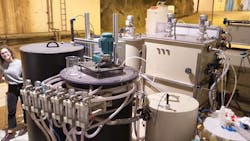Researchers turn wastewater nutrients into fertilizer
FINLAND -- Wastewater contains large amounts of nitrogen and phosphorus, which are valuable nutrients. NPHarvest is a process developed by Aalto University researchers that allows for the recovery of these nutrients in a way that produces a clean ammonium sulfate solution, which can be used as fertilizer, and a slurry rich in phosphorus and calcium. Using the NPHarvest process to produce recycled fertilizer can save both energy and natural resources, as it reduces nutrient discharges into waterways and cuts the amount of energy and chemicals consumed by aeration and wastewater treatment processes.
Developing a membrane
The NPHarvest process begins with the chemical coagulation of wastewater with lime dust, an industrial by-product. Coagulation allows for the harvesting of the phosphorus in the water. The separation of nitrogen in ammonium form is based on the use of a gas-permeable membrane. As an example, a biogas plant could achieve savings by using the NPHarvest process to treat its reject water on-site and turning it into fertilizer instead of conveying the water to a wastewater treatment plant and paying an increased wastewater charge.
"In the spring of this year we still had some doubts about the durability and cleaning of these membranes, as we had conducted only short-term experiments. This summer we had an opportunity to test the process over a span of several months, which also confirmed the feasibility of these membranes. We now know that the process works even in challenging environments, for example in the treatment of reject water from sludge digestion or leachate from a landfill," says Professor of Practice Anna Mikola.
Advancing circular economy with process chemicals
The strength of the NPHarvest process is that different end products can be produced from wastewater according to need. Nitrogen, for example, can be used as a general fertilizer in an ammonium phosphate form, while ammonium nitrate is used as an industrial chemical. Various organic polymers, such as starch, can be used like traditional coagulants in the recovery of phosphorus.
NPHarvest uses acid to bind nitrogen to the final product. Test runs conducted at a wastewater treatment plant in Viikinmäki also proved the feasibility of phosphoric acid for this use. In the future, phosphoric acid could be produced through the RAVITA process developed by HSY to recover phosphorus from wastewater.
"The customizability and adaptability of the process are important factors in the shift toward circular economy thinking, where one person's waste is raw material for another," Mikola adds.
